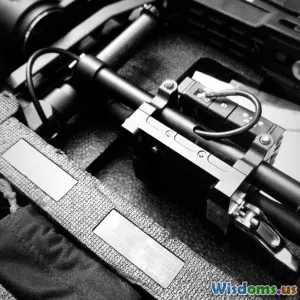Tracking Global Enforcement of the Chemical Weapons Convention
15 min read Explore global oversight in enforcing the Chemical Weapons Convention, revealing challenges, breakthroughs, and the path toward a world free of chemical weapons. (0 Reviews)Tracking Global Enforcement of the Chemical Weapons Convention
Introduction: Shadows and Safeguards
In a world increasingly shaped by rapid scientific advances and evolving conflicts, the specter of chemical warfare still looms, threatening human lives and international stability. The Chemical Weapons Convention (CWC), described as one of the most successful arms control treaties, pledges to free the world from these abhorrent weapons. But how effective are global efforts to actually ensure every nation complies? What real obstacles persist, and what mechanisms keep the world on course toward chemical disarmament?
Understanding how the international community tracks and enforces the CWC is essential for grasping both the remarkable progress achieved and the hard-won lessons yet to be learned. From meticulous inspections carried out by dedicated scientists, to the tense geopolitics behind continued violations, the global enforcement web is complex, dynamic, and continually tested—making its study both urgent and fascinating.
The Chemical Weapons Convention: A Brief Overview
A Landmark Treaty for Humanity
Formally opened for signature in 1993 and entering into force in 1997, the CWC is administered by the Organisation for the Prohibition of Chemical Weapons (OPCW). As of 2024, 193 states are parties to the treaty—a participation rate unmatched by nearly any other major international agreement, other than the United Nations Charter itself. The treaty's central aims are "to prohibit the development, production, acquisition, stockpiling, retention, transfer, or use of chemical weapons by States Parties."
Why the Urgency? Real-World Atrocities
Chemical weapons, from toxic gases in World War I to sarin attacks in the Syrian civil war, have left indelible scars on human history. The CWC was crafted in the aftermath of horrific 20th-century experiences, including Holocaust-era gas chambers and the widespread use of mustard gas and nerve agents. Even in recent decades, glaring examples persist: the 2013 Ghouta chemical attack in Syria claimed hundreds of lives and refocused the world's attention on the urgent need for effective enforcement.
The Machinery of Global Enforcement
Organisation for the Prohibition of Chemical Weapons (OPCW)
At the heart of enforcement lies the OPCW, headquartered in The Hague. It uses multilayered mechanisms to ensure compliance:
- Declaration and Inspection: States Parties must declare existing stockpiles and chemical production facilities. The OPCW conducts rigorous inspections (over 3,500 as of 2023), including ad hoc and challenge inspections.
- Destruction Verification: Countries are required to verifiably destroy all existing chemical weapons under OPCW observation.
- Laboratory Network: A network of over 25 designated laboratories worldwide analyzes environmental and biomedical samples from suspected chemical weapons use.
"The OPCW has overseen the destruction of more than 99% of declared chemical weapons stockpiles internationally." -- Organisation for the Prohibition of Chemical Weapons Annual Report, 2023
Secretariat and Technical Bodies
The OPCW Technical Secretariat, with over 500 staff from more than 80 nations, is responsible for technical verification, on-site inspections, and data analysis. The Scientific Advisory Board (SAB) provides crucial expertise, ensuring inspection methods keep pace with evolving technologies and threats.
Measuring Compliance: Successes and Shortfalls
Near-Universal Membership, but Not Quite
With only a handful of non-signatories—Egypt, North Korea, and South Sudan—and a few signatories pending ratification (notably Israel), the CWC has achieved global reach.
Yet, mere membership does not guarantee compliance. For instance:
- Russia completed its declared chemical weapons destruction in 2017, but lingering doubts remain about undeclared stockpiles or novel agents, particularly after the Novichok poisoning cases.
- United States declared complete destruction of its chemical weapons arsenal in July 2023, a milestone after years of delays due to technical and safety concerns.
Destruction of Stockpiles: A Tentative Victory
- More than 98% of the world’s declared chemical weapons, equating to over 72,000 metric tonnes, have been destroyed as of 2024—an unprecedented achievement. However, unannounced or clandestine holdings fuel suspicion.
- In Libya, civil unrest complicated the destruction process, but international assistance enabled safe removal and destruction of remaining sarin precursors by 2017.
Non-State Actors and Emerging Threats
The CWC is primarily oriented toward state actors, but modern threats increasingly arise from non-state groups—terrorist organizations or criminal syndicates—the 1995 Aum Shinrikyo sarin attack in Tokyo being a chilling example. The OPCW collaborates with Interpol and the UN Security Council to tighten controls on dual-use chemicals and related technologies.
Investigating Violations: The Real-World Frontlines
High-Profile Case: Syria
Syria acceded to the CWC in 2013, following horrific chemical attacks in Ghouta. Shortly after, OPCW and UN teams undertook a massive operation to verify and destroy Syria’s declared chemical arsenal. Yet subsequent attacks, notably in Khan Sheikhoun (2017) and Douma (2018), demonstrated persisting use of chlorine and nerve agents, raising contentious debates about attribution and accountability.
OPCW-UN Joint Investigative Mechanism (JIM) determined that Syrian government forces carried out several attacks, despite Damascus’ denials. In 2021, OPCW suspended Syria’s voting rights, a rare punitive measure meant to reinforce consequences for clear violations.
Russian Novichok Poisonings
The 2018 nerve agent attack in Salisbury, United Kingdom, targeting former Russian spy Sergei Skripal and his daughter, shocked the world and prompted an international outcry. Laboratory evidence linked the substance—Novichok, a class of highly potent military nerve agents—to Russian origins. The OPCW amended its schedules in 2019 to include novel Novichok compounds, marking a significant step in modernizing enforcement measures.
Challenges in Africa and Asia
While African and Asian states have largely joined the CWC, enforcement regularly encounters obstacles:
- Insufficient technical capacity or funding hinders full implementation of OPCW protocols.
- In conflict-torn nations like Sudan and Iraq, political instability restricts safe access for inspectors.
To address these, the OPCW runs capacity-building and training programs, supporting national authorities in developing effective chemical security infrastructure.
Mechanisms of Monitoring and Inspection
Routine and Challenge Inspections
- Routine Inspections: Regularly scheduled checks are conducted at chemical production facilities, research laboratories, and storage depots.
- Challenge Inspections: Any member state may request an ad hoc inspection if they suspect non-compliance by another state—though none have taken place due to political sensitivities.
Advances in Detection
Modern forensic science underpins the OPCW’s technical edge. Innovative mass spectrometry, high-resolution chromatography, and rapid field detection kits allow for unequivocal detection of CW agents down to the nanogram. Environmental, biomedical, and even archaeological samples inform investigations.
Digital Verification and Reporting
Digital record-keeping and satellite observation augment physical inspections. Remote sensing, machine learning, and AI-driven anomaly detection are increasingly integrated to monitor chemical industry activities and logistics networks worldwide.
Achievements and Breakthroughs
Converting Former Weapon Sites
Several former chemical-weapons facilities have been converted to civilian industrial sites or memorials. For example:
- Russia’s Kambarka chemical weapons destruction facility is now a model for international chemical safety education.
- Deseret Chemical Depot (Utah, USA), once America’s largest chemical weapons storage, has become a wildlife habitat and green zone.
Rapid Response Missions
The OPCW’s well-drilled rapid response teams have been mobilized on short notice for urgent investigations, often in high-risk conditions. In 2017, the UN-OPCW Joint Investigative Mechanism documented five major chemical attacks in Syria in less than a year, setting a precedent in crisis response.
Nobel Peace Prize
In recognition of its outstanding efforts, the OPCW was awarded the 2013 Nobel Peace Prize—a testament to both its technical effectiveness and humanitarian contributions.
"The conventions and agencies that safeguard us against the world's most dangerous weapons of war are a unique joint achievement by the nations of the world." —Thorbjørn Jagland, Chairman of the Norwegian Nobel Committee
Persistent Challenges and Roadblocks
Poisons with No Borders: Dual-Use Chemicals
Legitimate industries in agriculture, pharmaceuticals, and manufacturing rely on chemicals that can double as weapon precursors—a classic "dual-use" dilemma. Ensuring these do not slip into illicit hands requires a fine balance of regulation and economic pragmatism. In 2022 alone, INTERPOL tracked over 200 incidents of attempted illegal diversion of regulated chemicals in more than 30 countries.
Political Roadblocks and Verification Limitations
Enforcement mechanisms are most effective when supported by political will—which can wax and wane with shifting global alliances. Security Council deadlocks, selective transparency, and denials of inspector access, as seen repeatedly in Syria and North Korea, remain significant hurdles.
Evasion and Non-declared Programs
States with sophisticated scientific infrastructure can theoretically mask covert programs. Precursor stockpiling, shell companies, and civilian research fronts all test the practical limits of CWC enforcement.
Innovations Reshaping Global Enforcement
From Human Expertise to Artificial Intelligence
To counter increasingly subtle violations, enforcement agencies are leveraging AI-powered data analytics to mine suspicious trade patterns, laboratory procurement, or facility construction cues. The OPCW’s Data Analytics Platform, launched in 2021, integrates global customs, shipping, and trade data—flagging anomalies for human review.
Expanding Laboratory Networks
In 2024, OPCW’s laboratory network began collaborating with public health agencies—leveraging shared infrastructure to improve environmental monitoring. Sentinel "biosecurity" sensors placed near high-risk sites complement traditional sampling, creating a tighter net for early violation detection.
Public Awareness and Industry Partnerships
As the chemical industry becomes a vital partner, corporate compliance programs and industry-watchdog groups, like the International Council of Chemical Associations (ICCA), work with the OPCW to reinforce global chemical stewardship standards.
The Road Ahead: Urgency and Vigilance
The nearly universal ratification of the CWC marks a remarkable milestone in disarmament. Yet, the nature of enforcement is not static—chemical threats evolve alongside science, geopolitics, and technology. Remaining ahead requires technical innovation, clear-headed diplomacy, and vibrant public pressure.
Toward Total Disarmament
While compliance rates are high and declared stockpiles depleted, significant challenges remain: persistent clandestine programs, dual-use conundrums, and non-state actors’ ambitions. Effective enforcement is built not on punishment alone, but through persistent verification, international solidarity, technical innovation, and a deep-rooted societal revulsion toward chemical weapons.
What Can Individuals Do?
- Advocate for strong national chemical safety regulations and transparent governance.
- Support nonproliferation organizations and educational efforts to inform others.
- Hold governments accountable for transparency on international treaty commitments.
Conclusion: Towards a Safer World
The Chemical Weapons Convention stands as a beacon of humanity’s resilience against one of history’s greatest threats. Monitoring and enforcing its standards globally is a daunting, dynamic task—one made possible by scientific innovation, courageous investigators, informed citizens, and international commitment. Each successful intervention proves that vigilance pays off and that a world free from chemical weapons is not just aspirational, but achievable. The path forward will demand redoubled effort, cross-border cooperation, and unwavering resolve to ensure that the specter of chemical warfare remains banished, for this generation and those to come.
Further Reading & Resources
Rate the Post
User Reviews
Other posts in Chemical and Biological Weapons
Popular Posts
















